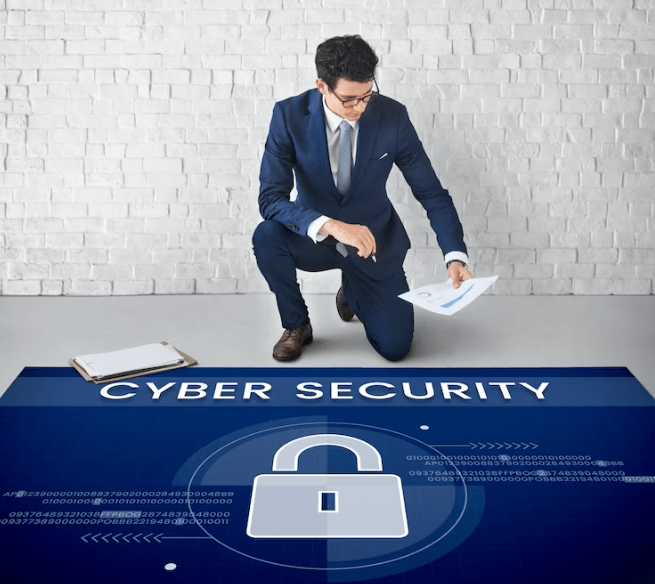
In the rapidly evolving business landscape, data-driven operations and remote work have become the norm. The work environment of today is quickly moving towards becoming more data-driven and remote. While the COVID-19 epidemic introduced an unprecedented rise in remote work, advancements in technology have enabled businesses to gather a wealth of additional information. However, it also increase the rise in cybercrimes. Therefore it is important to implement cybersecurity best practices to save business from cyberattacks.
Businesses widely recognize the benefits of remote work for their workforce. However, alongside this realization comes the unfortunate truth that hackers also see potential opportunities. Threat actors are taking advantage of the trend towards remote employment and conducting a variety of cyberattacks to target businesses and their sensitive data. At the same time, the majority of businesses place a high priority on enhancing employee productivity.
In any business, irrespective of industry, cybersecurity best practices and productivity are two essential pillars. However, striking a harmonious and effective balance between the two can prove to be a daunting task. Employees need access to company data throughout the workday, while IT professionals must ensure robust cybersecurity measures, including implementing cybersecurity best practices, are in place to safeguard this valuable information. The challenge lies in finding a seamless integration of these two functions to work in tandem and support the overall goals of the organization. So, how can these two crucial aspects work in harmony?

The global cybersecurity industry, driven by increased awareness and investments in security infrastructure, is projected to reach approximately $345.4 billion by 2026. As cybercrime becomes more sophisticated, organizations are prioritizing cybersecurity by allocating larger portions of their budgets. They recognize the crucial need to protect valuable data, employees, and critical assets.
In today’s interconnected world, hackers target companies of all sizes, including critical healthcare infrastructure and small businesses. Consequently, cybersecurity has become an integral part of standard operating procedures for modern businesses. This shift has fueled the demand for certified IT professionals specializing in cybersecurity. Companies understand the risks involved and the necessity of safeguarding their data, employees, and vital assets.
Basic security measures are no longer enough, and businesses must adhere to new IT security guidelines and implement cybersecurity best practices to mitigate cyber threats effectively.
The significance of overall employee performance cannot be overstated when it comes to achieving success in any business. In today’s fiercely competitive landscape, productive workers are indispensable, as their contributions directly impact profitability. Productivity, along with implementing cybersecurity best practices, plays a pivotal role in the smooth functioning of business operations. While many employees have reported increased productivity during the pandemic-induced shift to remote work, the research findings on this matter remain inconclusive. However, a study conducted by The Predictive Index (PI) revealed that in 2020, 56% of CEOs identified employee performance as a top concern. Although maintaining high productivity is the ultimate objective, it is not without its challenges. By incorporating cybersecurity best practices, businesses can ensure data security while optimizing workflow and fostering a productive environment.

With the prevalence of remote work, companies often allow employees to use personal devices for a flexible work environment. However, the convenience of this arrangement comes with inherent risks, as a stolen device can potentially lead to a security breach, causing harm to the company’s operations. Implementing multiple layers of cybersecurity measures can inadvertently hinder productivity, creating obstacles for employees. Today’s businesses find themselves grappling with a challenging dilemma, trying to strike a balance between cybersecurity and productivity. A single data breach can result in significant financial losses, potentially amounting to thousands or even millions of dollars, while low productivity levels can hinder a company’s ability to meet its bottom line.
Navigating this dilemma requires a careful approach, where both security and productivity are given due consideration. Companies must prioritize the implementation of robust cybersecurity measures while simultaneously finding ways to empower employees to achieve optimal productivity. By finding the right balance, businesses can safeguard their valuable assets while ensuring that their workforce remains efficient and effective in an evolving work landscape.

In the modern business landscape, empowering employees to uphold productivity while safeguarding valuable assets is crucial. Achieving a harmonious integration of cybersecurity and productivity is essential for businesses to thrive and ensure their safety and optimal output. Fortunately, there are several approaches to strike a balance between these two critical aspects. Here are some effective strategies for businesses to unify cybersecurity and productivity:
Complex cybersecurity measures may lead employees to circumvent protocols, compromising security. When employees view cybersecurity as an obstacle, they tend to seek alternative methods instead of adhering to established protocols. This could involve resorting to unauthorized file-sharing apps, employing weak passwords for convenient account access, or relying on personal devices to fulfill tasks. Consequently, it becomes imperative to adopt a layered approach and streamline cybersecurity measures for employees. For instance, if regular password changes are a standard practice, ensuring that workers utilize a password manager simplifies the process. By doing so, accounts remain secure, and individuals can conveniently access their information.
IT teams must adopt the latest cybersecurity practices to safeguard company data. To safeguard the company from potential cybersecurity threats, IT teams must embrace the most effective cybersecurity practices. In addition, employees entrusted with the responsibility of securing business data should explore the adoption of innovative storage technologies or widely utilized cloud-based services for their IT infrastructure. Cloud infrastructure offers a range of advantages and disadvantages. Notable benefits encompass reliability, cost-effectiveness, security, and the flexibility it provides to employees, enabling them to sustain productivity even while working remotely.
Investing in effective employee collaboration tools is another approach to striking a balance between cybersecurity and productivity. Collaboration is essential for achieving high levels of productivity, as teams need to work together seamlessly. Fortunately, numerous widely-used collaboration tools offer enhanced security features to safeguard companies and their valuable data. Examples of such tools include Microsoft Teams, Slack, and Trello, which serve as reliable collaboration platforms or project management software (PMS). These tools empower teams to enhance productivity while ensuring data security remains uncompromised. Depending on the organization’s size, budget, and specific requirements, some companies may choose to utilize paid collaboration tool options, while others may opt for free versions that still meet their needs.
Comprehensive employee cybersecurity training is an essential prerequisite for any company aiming to prioritize cybersecurity. The education of end-users plays a pivotal role in devising an effective strategy. It is crucial to recognize that hackers often exploit a company’s weakest link, typically targeting employees through phishing scams, as highlighted by the Harvard Business Review (HBR). By imparting knowledge about best cybersecurity practices to employees, potential threats can be thwarted before they materialize. Moreover, as employees gain a deeper understanding of cybersecurity and its significance, their perspectives are likely to shift. As a result, when employees feel more at ease utilizing built-in security tools, productivity can rise due to the diminished perception of cybersecurity as a hindrance.
Instead of viewing cybersecurity and productivity as distinct domains, it is beneficial to forge a partnership between the two. Undoubtedly, finding equilibrium can be challenging in today’s rapidly evolving environment. However, it is crucial to recognize that the key lies in striking this balance. When employees are equipped with the appropriate tools to achieve optimal productivity while safeguarding critical data, everyone emerges as a winner.
By finding a harmonious integration of cybersecurity and productivity, businesses can navigate the ever-changing landscape while ensuring the security of their assets. Prioritizing both aspects and empowering employees with the knowledge and tools to protect data will contribute to the long-term success of the organization.
WhatsApp us